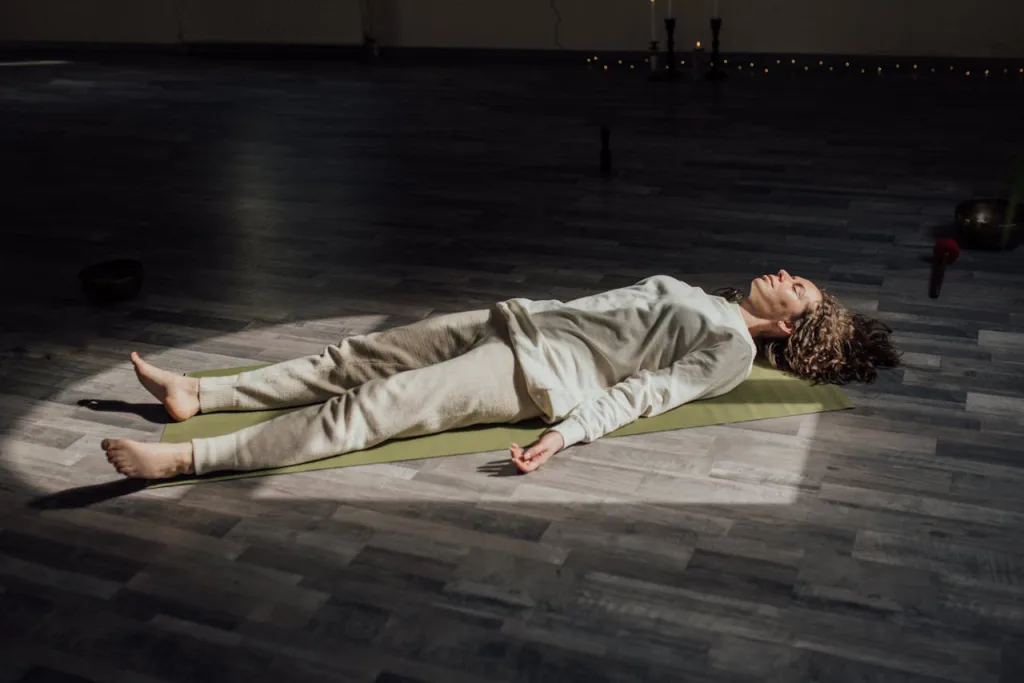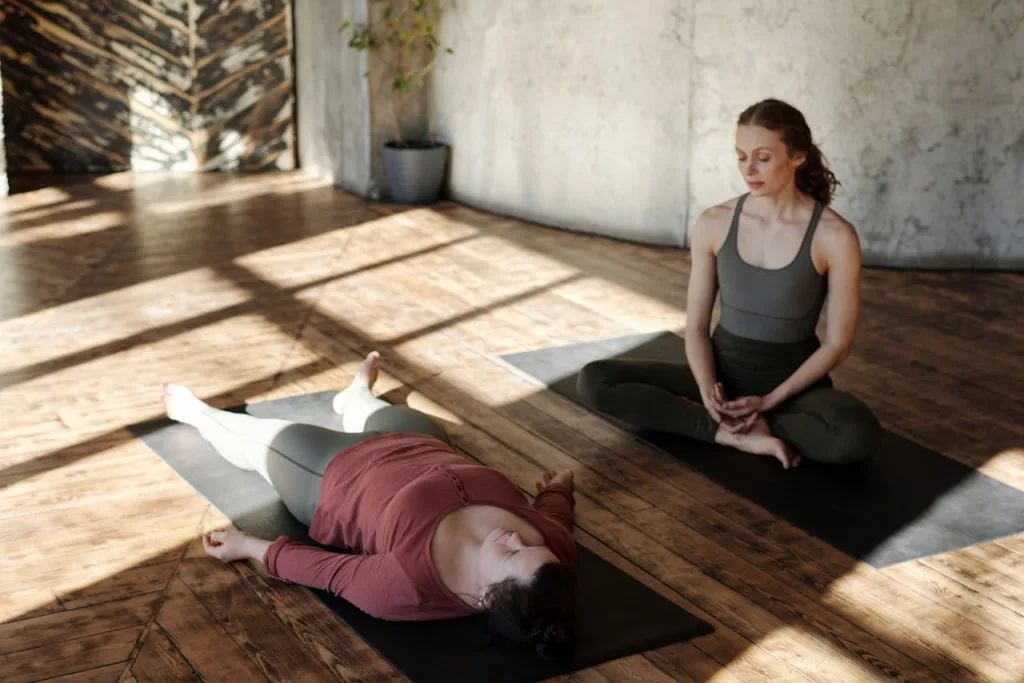Yoga Nidra, often called “yogic sleep,” is an old practice ingrained in the traditions of yoga and meditation. Unlike traditional yoga, it does not involve postures but focuses on reaching a state of conscious awareness. You practise it lying down with your eyes closed. It differs from meditation in that you don’t have to try to be aware; instead, you are resting as awareness itself.
When practising Yoga Nidra, you reach a state between wakefulness and sleep, allowing for deep rest and physical, mental, and emotional recovery.
History of Yoga Nidra
Early Yoga Nidra concepts date back over 3,000 years in the Vedas and Upanishads.
Yoga Nidra practice evolved significantly within the tantric tradition in the early centuries CE, emphasizing techniques for exploring consciousness beyond ordinary states.
In modern times, Swami Satyananda Saraswati of the Bihar School of Yoga formalized and popularized Yoga Nidra in the mid-20th century. He presented it as a powerful physical, emotional, and spiritual healing tool and helped Yoga Nidra practice spread globally.
The practice gained further attention in the West, especially in psychology and medicine, where it was explored for its benefits in stress reduction and trauma recovery.
Dr. Richard Miller’s adaptation of Yoga Nidra into the iRest method brought the practice into psychological health settings, including use by the U.S. military for treating PTSD(1).
Today, Yoga Nidra is widely practised worldwide to achieve deep relaxation, improve sleep, and achieve mental clarity. It blends ancient wisdom with modern therapeutic applications, and with the help of Dr. Andrew Huberman, it is becoming even more popular.
Yoga Nidra practise steps
Although there are many variations and different lengths of Yoga Nidra practises, here is a list of steps that should be followed when practising Yoga Nidra:
- Preparation: settling into a comfortable lying position in a calm environment with your eyes closed
- Setting an Intention: a short, positive statement or affirmation for a desire or goal.
- Body Scan: it involves focusing your attention on specific body parts directing awareness, and noticing sensations. It helps relax the body and draws the mind inward, away from external distractions.
- Breath Awareness: paying attention to natural or guided breathing and noticing the breath flow to further deepen the relaxation.
- Sense Perception and Opposites: This stage brings awareness to contrasting sensations or emotions, such as hot and cold, heaviness and lightness, joy and sorrow. This part of Yoga Nidra aims to balance the nervous system and release stored emotions.
- Visualization involves imagining specific images, symbols, or scenarios. It helps access deeper layers of the subconscious and boost mental clarity, emotional release, and insight.
- Reaffirming the Intention: Reinforce it in a relaxed state, where it is more likely to imprint on the subconscious mind.
- SlowllyComing Back: bringing the attention back to the presence and surroundings and slowly opening the eyes.
- Reflection and Closure: Some practices may include a reflection or a closing ritual, such as expressing gratitude or setting a mindful intention for the rest of the day.
Here are the nine steps of a full Yoga Nidra practice; however, you can make many alterations to suit your needs. Some practices only include body scans, and some do not require setting an intention. You can find 10 to 20 minutes long (most common) practices, extremely deep and long, up to an hour.
What does NSDR stand for, and how it’s different from Yoga Nidra
If you listen to Andrew Huberman’s podcast, you will know the term NSDR. NSDR stands for Non-Sleep Deep Rest and refers to practices promoting rest and recovery without needing sleep.
NSDR practices include Yoga Nidra, Body Scan Meditation, and Self-Hypnosis. In an interview, Dr. Andrew Huberman mentioned that he refers to the practice as NSDR to appeal to a broader Western audience that would dismiss a practice with the word “Yoga” in it.
You can watch this short video of Andrew Huberman explaining NSDR and Yoga Nidra in more detail.
Benefits of Yoga Nidra or NSDR
Like with all holistic practises, it isn’t easy to measure benefits, and there are only so many studies about Yoga Nidra. Let’s look into scientific evidence of the benefits of Yoga Nidra we have so far:
- Reduces stress and anxiety(2)(3)
- Improves sleep quality(3)(5)(6)
- Enhances Mental Health(4)(5)
- Boosts Cognitive Function(6)
- Improvement in hormonal imbalances, migraines and pain (3)(4)
To summarise the benefits of Yoga Nidra:
Studies suggest that Yoga Nidra is effective in reducing stress, anxiety, depression, and insomnia, improving sleep quality and cognitive functions, as well as providing deep relaxation and physiological rest and even improving pain.
Who Should Practise Yoga Nidra?
Yoga Nidra is an inclusive practice that can be adapted to suit nearly anyone, regardless of age, physical condition, or experience level.
It is great for students who are learning a lot and feel stressed. Yoga Nidra is an amazing practice for people suffering from insomnia or other sleep disorders. It is also great for older people with limited mobility or wanting to improve their cognitive function and anyone seeking emotional balance and seeking a deeper connection with themselves.
Here are my favourite Yoga Nidra or NSDR practices online That I keep coming back to:
10 minute no music NSDR by Andrew Huberman
20 minute with music NSDR by Andrew Huberman
20-minute Non Sleep Deep Rest Yoga Nidra with Relaxing Music by Ally Boothroyd
10 Minute Yoga Nidra Guided Meditation to Relax with Ocean Waves & Breath to Calm the Nervous System by Ally Boothroyd
15 minute Yoga Nidra for relaxation with music by RosalieYoga
15 Minute Yoga Nidra, no music with Yoga by Tim Senesi
15 Minute Yoga Nidra Body Scan Practice, no music, with Kelly Boys
25 minute NSDR/ Yoga Nidra, no music, with Kamini Desai- Balance Point
30 minute NSDR/ Yoga Nidra, no music, with Kamini Desai– Healing Recharge
Choosing Yoga Nidra or NSDR for your specific needs, mood, and preferences, such as music or no music, male or female voice, setting intentions and visualizations, or focusing on body scan and breath is important.
If you like this article, check out THE BEST GUIDED MEDITATION YOUTUBE CHANNELS,
also THE BEST BREATHWORK CHANNELS ON YOUTUBE FOR ALL LEVELS
Learn about Gratitude practice: Why Gratitude Works: The Benefits and How to Practice It Daily.
You can also learn about Chair Yoga: Free Chair Yoga for Seniors: Best Beginner-Friendly Exercises & Videos
To summarise
Yoga Nidra or NSDR:
Yoga Nidra’s history reflects its deep roots in ancient spiritual traditions, its evolution through various schools of yoga and tantra, and its modern adaptation and scientific validation. The practice continues to be a significant part of global spiritual and wellness practices, and it is great to see it evolve and spread in modern society.
Do you have any favorite Yoga Nidra or NSDR tips or practices you would like to share? Comment below, namaste 🙏
Please Note: This post is for informational purposes only and is based on research. It’s not medical advice. It’s always best to consult a healthcare professional with health concerns. Enjoy practicing!
- https://shop.irest.org/pages/about-irest
- Musto, S., & Vallerand, A. (2023). Exploring the uses of yoga nidra: An integrative review.. Journal of nursing scholarship : an official publication of Sigma Theta Tau International Honor Society of Nursing. https://doi.org/10.1111/jnu.12927.
- Kumari, M., & Karunaratne, H. (2022). Therapeutic Effects of Yoga Nidra: A Review. International Journal of Health Sciences and Research. https://doi.org/10.52403/ijhsr.20221224.
- Kim, S. (2017). Psychological effects of yoga nidra in women with menstrual disorders: A systematic review of randomized controlled trials.. Complementary therapies in clinical practice, 28, 4-8 . https://doi.org/10.1016/j.ctcp.2017.04.001.
- Gunjiganvi, M., Rai, S., Awale, R., Mishra, P., Gupta, D., & Gurjar, M. (2023). Efficacy of Yoga Nidra on Depression, Anxiety, and Insomnia in Frontline COVID-19 Healthcare Workers: A Pilot Randomized Controlled Trial.. International journal of yoga therapy, 33 2023. https://doi.org/10.17761/2023-D-22-00011.
- Datta, K., Bhutambare, A., L, M., Narawa, Y., Srinath, R., & Kanitkar, M. (2023). Improved sleep, cognitive processing and enhanced learning and memory task accuracy with Yoga nidra practice in novices. PLOS ONE, 18. https://doi.org/10.1371/journal.pone.0294678.
Silvija Meilunaite, PN1-NC, CSMC, is a certified nutrition and menopause coaching specialist, and a writer in the nutrition and self-improvement field. She explores science-based approaches to holistic health and plant-based nutrition, with a strong focus on researching clean, non-toxic products that support long-term well-being.
- S. Meilunaitehttps://barefootbasil.com/author/silvootegmail-com/
- S. Meilunaitehttps://barefootbasil.com/author/silvootegmail-com/
- S. Meilunaitehttps://barefootbasil.com/author/silvootegmail-com/
- S. Meilunaitehttps://barefootbasil.com/author/silvootegmail-com/





Thank you for the post on this gentle yet powerful practice. Yoga Nidra is well received by many veterans who struggle with chronic pain and the effects of trauma. It can be a highly meaningful and valuable adjunct to more traditional forms of therapy. Always accessible, free of cost, relaxing and effective. Practicing little and often can create positive shifts in how one thinks and feels as they move through the day. It can be a lot to search through all the content out there, but it’s important to find the voice, cadence and style that suits you best. I’m adding another choice to your list in case it is helpful. I recommend the trauma informed practices on YouTube at @katiepecson
Thank you for reading 🫶